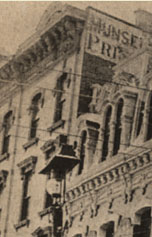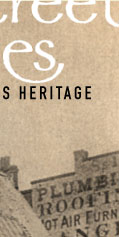|
|
|
Drawing from Old Albany, Photos, Vol.
2,
Albany, New York: Morris Gerber Collection, 1965.
|
|
Charles Grant Davidson (1865–1945)
State and Pearl Street, Albany, 1889
Oil on canvas
17 x 19 inches
Gift of Mrs. Isaac Hasbrouck Chahoon in memory of Joseph H. Ramsey
1949.10.4 |
|
|
Unidentified photographer
A. F. Waldbillig’s Photography Studio on Southeast Corner
of State and Pearl Streets
[Schuyler-Staats House, ca. 1878]
Copy print
9 x 7 inches
Gerber 11, 1993.010.2026.1p
|
|
Gary Gold
IBM Building, 2002
Inkjet print
8 x 4 inches
|
|
Southeast Corner of
State and Pearl Streets
The house depicted in the painting by the artist, Charles Grant Davidson,
is a modernization of a two part house built about 1659-1667 by Philip
Pieterse Schuyler (1628-1683). The original Schuyler house stood on the
corner of State (Joncker) Street and what would become South Pearl Street.
Formerly the words Anno Domini, in iron letters, ran across the front
of the two part house, and over the upper story the year 1667 was written,
also in iron. The house stood there when South Pearl was a lane [known
as Washington Street until ca. 1794] and entered by using a gateway.
About 1763, Margarita Schuyler, the granddaughter and namesake of her
grandmother, Margarita Van Slichenhorst Schuyler (who died in 1711), moved
into the upper (West) house and lived there until her death in 1782. In
1777, the lower (East) house where many of the prominent Schuyler’s
grew up was purchased by Henry Staats, at which time it was already held
by Richard Cartwright, a tavern keeper and merchant who had been transported
to North America as a convict in 1743.
After the [Revolutionary] war the property continued as a multi-use business/residence
for Henry Staats’ widow, Anna (1747-1829) and, then, for her sons
who were druggists.
In 1782 the upper (West) house became the City (Lewis’) Tavern,
and was the leading hotel in Albany until The Tontine was built across
the street on the north side. The Tontine Coffee House and Hotel with
its raised entrance can be seen in the watercolor #2 State Street by James
Eights.
In 1798, City Tavern was demolished when Pearl Street was widened. The
east house shown in the Davidson painting still showing the word Anno
on its upper story, was demolished in 1887 and became the site of the
Albany County Savings Bank (see photograph on right). It was the oldest
house in Albany for which a photograph has survived.
Text compiled from: Waite, Diana S. Albany Architecture,
Albany, New York: Matthew Bender IV and Mount Ida Press, 1993; NYS Museum
Colonial Albany Social History Project website; History of Albany County;
and additional research.
Tyrone Power’s* Impressions
of Albany
Ca. 1830
“This is the capital of the powerful state of New York, and promises
at no very distant period to wear an aspect worthy of its rank. No situation
was ever chosen better adapted to display; for the town is built over
the face of a lofty and steep hill, which only affords space for one or
two streets about its foot, and this is chiefly occupied by docks and
the several canal basins connected with the Hudson.
The principal avenue, a regularly built, grandly proportioned street,
with a railway running through its center, climbs directly up the hill,
and is terminated by a well-kept public square, or Grande Place, as the
French would call it, about which the State House, City Hall, and other
public buildings are ranged. These striking objects from the nature of
the ground, stand boldly out, and have all an appearance sufficiently
imposing; whilst here are some buildings that possess strong claims to
architectural beauty.
Nearly all the more important public offices have lofty and well-proportioned
domes; and these being uniformly covered with tin or other bright metal,
impart a gay and picturesque effect to the general mass; and indeed, the
city, viewed from a little distance, with all these cupolar and towering
domes reflected in the setting sun, assumes quite an oriental appearance;
one is immediately reminded of the mosque and minaret of some Turkish
capital; the fine marble too used in the construction of all public buildings,
and indeed of many private ones, increases the effect which they derive
from their style and from the bold eminence they occupy.
Albany was long almost exclusively Dutch, and may be said up to that time
to have hardly kept pace with the rapid advance of the country generally;
it must have marveled at the spread of the numerous flourishing towns
which have grown up around within a few years, and which threatened to
eclipse, if not extinguish it wholly. A movement, however, has of late
taken place; the inhabitants have awoke, new colonists have superseded
the family from Sleepy-Hollow, or imparted to them a share of their energy;
and Albany begins to assert her claim on the productive country by which
she is backed and to turn into her own channel a portion of its commerce.
Building is everywhere going forward; land has doubled and trebled in
value; improvements are in steady progress; and should the present prosperous
course of things meet with no untoward check to paralyze the industry
of the people, Albany will in a few years assume an importance more profitable
to its citizens than the empty honor it derives from being styled the
capital of the state.”
Munsell’s Annals of Albany, 2nd Edition
(1869)
*Tyrone Power (1795-1841) was a famed Irish stage personality,
grandfather of Tyrone Power II (1869-1931) also an actor. He was the great-grandfather
of the film actor, Tyrone Power (1914-1958).
|




